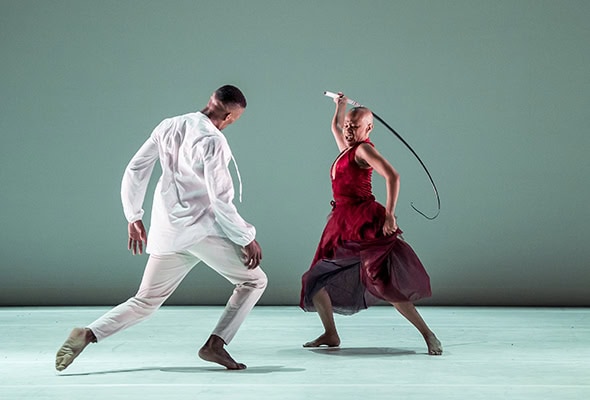Dada Masilo’s Giselle for Dance Consortium at Sadler’s Wells
Posted: October 9th, 2019 | Author: Nicholas Minns | Filed under: Performance | Tags: Dada Masilo, Dance Consortium, David Hutt, Giselle, Liyabuya Gongo, Llewellyn Mnguni, Lwando Dutyulwa, Nonofo Olekeng, Philip Miller, Sinazo Bokolo, Songezo Mcilizeli, Suzette Le Sueur, Théophile Gautier, Tshepo Zasekhaya | Comments Off on Dada Masilo’s Giselle for Dance Consortium at Sadler’s WellsDada Masilo’s Giselle at Sadler’s Wells, October 4

Seeing two revisions of Giselle at Sadler’s Wells in as many weeks — Akram Khan’s version presented by English National Ballet and Dada Masilo’s recreation as part of a Dance Consortium tour — is perhaps an accident of programming but they inevitably offer comparisons of approach. Any contemporary revision of a classical ballet that seeks to justify adopting its name requires an understanding of the original structure on which to build an updated narrative. But why revise the ballet in the first place? Théophile Gautier’s Giselle does not resonate today because of its fascination for Romantic tropes of the irrational and supernatural, but because its story of love, betrayal and forgiveness expressed through Jean Coralli’s choreography and Adolph Adam’s music can still evince a powerful emotional effect on a contemporary audience. The challenge, then, of any revision is to generate this kind of emotional resonance through a new gestural vocabulary, music, sets and costumes.
Dada Masilo’s Giselle, in which she dances the eponymous role, begins as a vibrant re-telling of the narrative set in a village in her native South Africa on a hot and languorous day with Giselle’s mother (Sinazo Bokolo) clutching her aching back as she sweeps around the chattering, bantering villagers. Hilarion (Tshepo Zasekhaya) rushes in clapping his hands to get everyone on their feet and back to work before Albrecht (Lwando Dutyulwa) and Bathilde (Liyabuya Gongo) make their entrance; Masilo has replaced the entitlement of the original ballet’s class structure with wealth, so while Albrecht and Bathilde are dressed in fine indigo robes they appear to have much in common with the villagers, even if Bathilde’s extrovert manner arouses some jealousy among the women. This lack of class division is reminiscent of the social cohesion in the benchmark revision of another classic, Romeo and Juliet, by Jerome Robbins and Leonard Bernstein.
Masilo is helped here by Philip Miller’s intelligent, sensitive score that samples phrases from Adam’s original to signal key moments in the musical narrative while introducing earthy African rhythms on which the villagers, and later the Wilis, can dance. Masilo’s choreography — a mix of classical steps with the energy of tribal dance liberally sprinkled with colourful everyday gestures and high-spirited banter — gives the story a delightful realism and is put to the service of fleshing out the psychology of her principal characters; the inner workings of Albrecht and Hilarion are embodied in their respective solos and differentiated in their confrontation, while Bathilde is given an extrovert personality to stand out from the already ebullient villagers. Giselle’s mother’s drunken cameo and Giselle’s dream sequence are particularly poignant.
It is in the transition from the first to the second act that Masilo starts to bend the narrative to her own agenda. Her mad scene sees her at her most vulnerable, mocked and stripped by the villagers, an outcast who has lost everything, but her physical presence has a sense of fragility mixed with a sensual pluck that will resonate more with her conception of the Wilis: she replaces the hapless maidens with a gender-neutral pack of voracious warriors under the tutelage of a vengeful Myrtha (Llewellyn Mnguni). They prowl the stage in blood-red costumes in search of male prey, hoovering up first Hilarion and then Albrecht. Albrecht? Doesn’t Giselle’s love and forgiveness save him? Not here; the closest Giselle gets is the moment she appears to assuage a frightened Albrecht with a gentle caress and a kiss through closed eyes before slaying him. It’s a chilling reminder that Masilo has replaced forgiveness with revenge. Although the reversal has connotations for the #Metoo campaign, it also aquires profound political sensitivity in the aftermath of South Africa’s truth and reconciliation commission.

Even if the ending robs Gautier’s narrative of its catharsis, Masilo has only pushed the envelope of the story to a logical degree within a contemporary context. All the theatrical elements work seamlessly together to condense the action succinctly within a sixty-minute performance. The one drawback is an additional ten-minute ‘technical pause’ between the first and second act narratives that dissipates the tension Masilo has so carefully constructed at the very moment she introduces the emotional core of her revision. While the imagery is strong, subtlety flees in the ensuing melee. Masilo pulls back from leaving us with a brutish taste of revenge through an image of Giselle blowing a cloud of white dust over the body of Albrecht that neatly inverts Gautier’s original scene of Albrecht’s remorse. The dust, suspended in the light, is Masilo’s gesture of redemption.
Lighting: Suzette Le Sueur with assistance from Thabiso Tshabalala
Costumes: David Hutt of Donker Nag Helder (Act 1), Songezo Mcilizeli & Nonofo Olekeng of Those Two Lifestyle (Act 2)
For an in-depth alternative perspective, see Hannah Hutchings-Georgiou‘s review on LucyWriters platform.